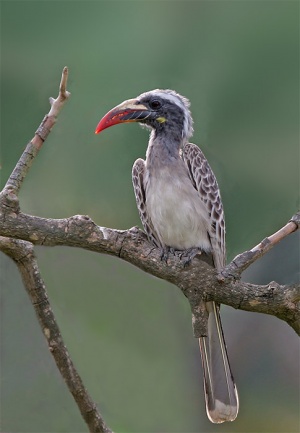- Lophoceros nasutus
Identification
45–51 cm (17¾-20 in)
- Grey body, head, flight feathers and long tail are darker
- White line down each side of the head and one on the back (visible only in flight)
- Long curved bill (black in male, female has red mandibles)
- Small casque and a creamy horizontal stripe.
Immature birds are more uniformly grey.
Distribution
Africa and the Arabian Peninsula
Western Africa: Mauritania, Senegambia, Senegal, The Gambia, Guinea-Bissau, Guinea, Mali, Sierra Leone, Liberia, Ivory Coast, Burkina Faso, Ghana, Togo, Benin, Nigeria, Niger, Chad, Cameroon, Central African Republic, Equatorial Guinea, Gabon, Congo, Angola
Eastern Africa: Sudan, Eritrea, Ethiopia, Somalia, Kenya, Uganda, Rwanda, Burundi, Tanzania, Zambia, Mozambique, Malawi
Southern Africa: Namibia, Botswana, Zimbabwe, South Africa, KwaZulu-Natal, eSwatini
Middle East: Arabian Peninsula, Saudi Arabia, Yemen
Taxonomy
Formerly placed in the genus Tockus.
Subspecies
Lophoceros nasutus has 2 subspecies[1]
- L. n. nasutus:
- Senegambia to Ethiopia, Kenya and Uganda; Arabian Peninsula
- L. n. epirhinus:
- Southern Uganda and south-eastern Kenya to northern South Africa
Habitat

Photo © by max1
Satara, Kruger National Park, South Africa, September 2018
Riverine bush, deciduous woodland, open savanna, edges of sub-desert and grassland .
Behaviour
Diet
Their main diet consists of insects, especially arboreal grasshoppers, beetles, mantids and scale insects. They also eat larger prey, such as tree-frogs, chameleons and lizards.
Breeding
Their clutch contains 2-4 white eggs which are laid in a tree hollow; this is blocked off during incubation with a cement made of mud, droppings and fruit pulp. There is only one narrow aperture, just big enough for the male to transfer food to the mother and the chicks. When the young and the female are too big to fit in the nest, the mother breaks out and rebuilds the wall, then both adults feed the young.
Vocalisation
Generally unobtrusive, they are inclined to call at sunrise, emitting a series of shrill piping whistles which varies in speed but often rises to a crescendo with the bird's head is thrown back the whole body trembling with the effort.
References
- Clements, J. F., T. S. Schulenberg, M. J. Iliff, D. Roberson, T. A. Fredericks, B. L. Sullivan, and C. L. Wood. 2018. The eBird/Clements checklist of birds of the world: v2018. Downloaded from http://www.birds.cornell.edu/clementschecklist/download/
- Avibase
- Handbook of the Birds of the World Alive (retrieved December 2018)
Recommended Citation
- BirdForum Opus contributors. (2025) African Grey Hornbill. In: BirdForum, the forum for wild birds and birding. Retrieved 28 April 2025 from https://www.birdforum.net/opus/African_Grey_Hornbill
External Links
GSearch checked for 2020 platform.1






